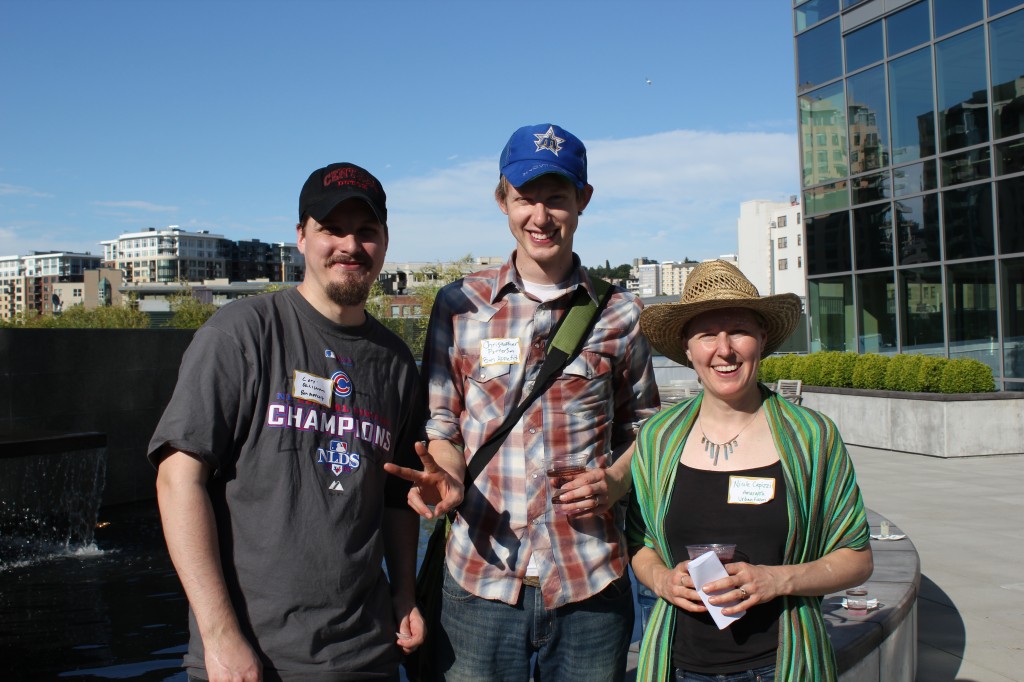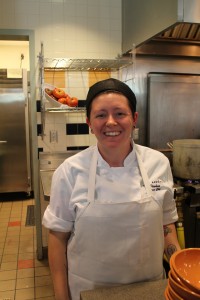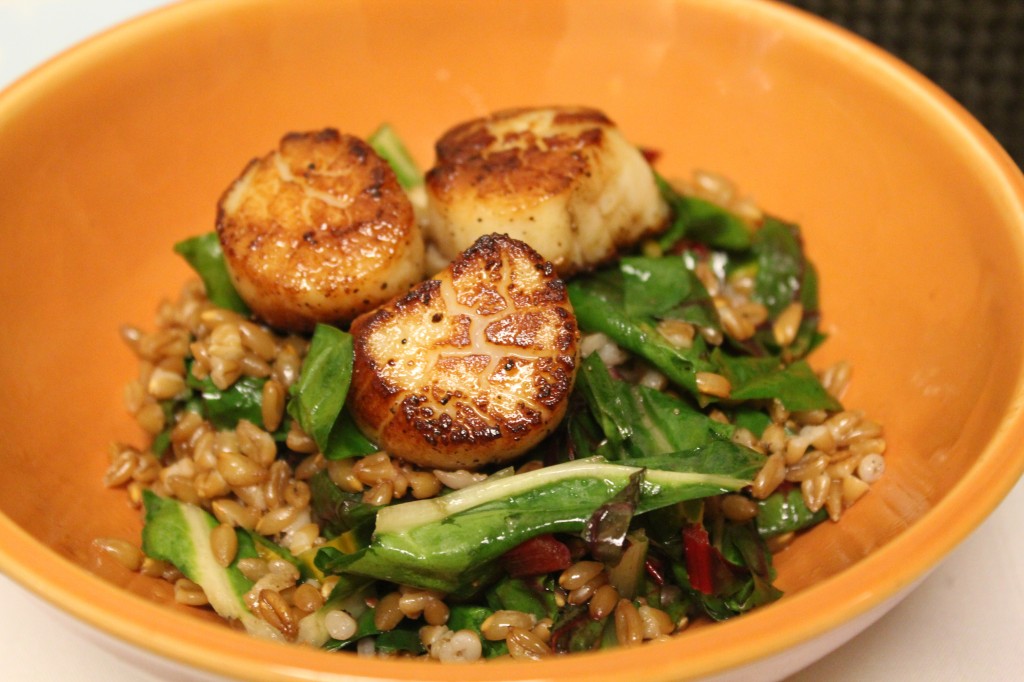Recipe: Bon Appétit at Nordstrom’s All-Local Scallops, Chard, and Farro
- by Vera Chang

From left to right: Bon Appetit at Nordstrom's Cory Dahlstrom, Executive Chef Christopher Patterson, and Amaranth Urban Farm's Nicole Capizzi
The Eat Local Challenge has become one of my favorite celebrations each year. While many of our usual holidays come with prescribed dishes, such as turkey and stuffing for Thanksgiving, brisket and matzoh ball soup for Passover, and cookies topped with red and green sprinkles for Christmas, the Eat Local Challenge menu is always different — year to year, chef to chef, and region by region. The challenge is to create an whole menu where every ingredient (except for salt) comes from within 150 miles. While this is no easy task, I also find the challenge to be encouraging. Whether a chef or an eater, it encourages everyone to explore unusual flavors – found on our local farm and range lands and in our forests, lakes, and oceans, to learn about new producers, and tap into our inner creative spirit.
This year for the Eat Local Challenge, I went to Bon Appétit Management Company’s The Dish and The Fashion Bowl cafés at Nordstrom in Seattle, WA. A dish that won rounds of praise from our guests: seared scallops, braised rainbow chard, and cipollini onions with toasted whole-grain emmer farro, finished with Siegerrebe wine (pictured below). Here are some producers that Sous Chef James Edmunds highlighted in his dish, great folks to know about if you’re local to the Puget Sound area:
The Taylor family of Taylor Shellfish has been growing shellfish in the bays and inlets of the Puget Sound for over 100 years. Their farms are some of the most beautiful and nutrient-rich tidelands in the world. Amaranth Urban Farm is a woman-owned, small-scale, organic farm just eight miles from the Space Needle, the only commercial-scale farm within Seattle’s city limits. Bluebird Grain Farms got their name because “Bluebirds are a reminder that every single thing we do as farmers is connected to—and impacts—the environment at large.” Their emmer, known as faro in Italy, is an ancient ancestor of wheat that’s incredibly versatile, with a wonderfully full-bodied flavor and robust nutritional value. Emmer is high in protein, ranging up to 22%, and low in gluten, making it a great choice for people who are sensitive to more common, hybridized types of wheat. Thirty-five miles from Bon Appétit at The Dish, Whidbey Island Winery makes Siegerrebe that explodes with floral aromas, spice, and flavors of grapefruit, honey, pear, apricot, and lichee nut and is a delight with spicy food and shellfish.
I love that there’s no need for long flights home for the Eat Local Challenge – it’s a celebration of wherever you are. I wish that every holiday we celebrated would, whilst providing joy and an excuse to partake in a ritual out of the ordinary, challenge us to be more ecologically sustainable and locally rooted.
As I type, it’s nearing dusk. I head into my garden to pick an all-local sun gold cherry tomato, basil, parsley salad topped with calendula and borage. I reflect on the how every year I celebrate the Eat Local Challenge and the many Bon Appétit chefs and Farm to Fork suppliers I meet throughout the year, the less of a challenge it is to eat more locally and sustainably every day. The Eat Local Challenge is a holiday that I can grow and change with and celebrate every day.
Chef James Edmunds’s Eat Local Challenge Seared Scallops
Serves 6 people
• 30 Taylor Shellfish scallops (or 5 scallops per person)
• 6 Amaranth Urban Farm cipolini onions per person, halved – two halves per serving
• 6 bunches Amaranth Urban Farm rainbow chard
• 6 cups Bluebird Grain Farms farro
• ½ lb butter, or two sticks clarified
• 1 bottle Whidbey Island Winery Siegerrebe wine 1 bottle of wine
• 3 cups vegetable broth
The farro and the cipollini onions will need to be cooked first.
For the cipollini onions: Trim at the leaf end and the root end, leaving just the bulb. Toss in salt, black pepper, and olive oil. Then roast them for 10-15 minutes, or until the tops the bottoms are darkly caramelized and the tops begin to brown.
For the farro: You can either boil the farro in salted water until al dente, or sauté with onions, salt and pepper. (Chef James prefers the latter.) If you saute, you’ll want to deglaze with a splash of Siegerrebe (or other white wine), then simmer in vegetable stock. Since the farro will absorb the vegetable stock, add more vegetable broth as it cooks.
After the cipollini onions and farror are cooked, season the scallops with salt and pepper. Heat one pan and add the butter. Then add the scallops salt and pepper side down. This helps get a nice sear.
While the scallops are cooking in one pan, add the already cooked farro and a splash of vegetable stock to another pan. Once all the stock has been absorbed, add the cipollini and chard. Deglaze with the wine (and some butter, if you wish) and toss together.

